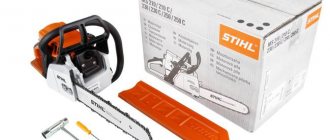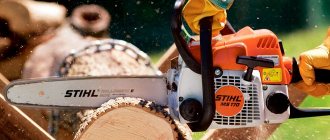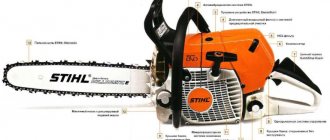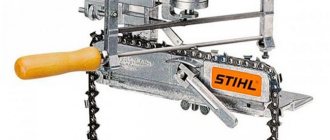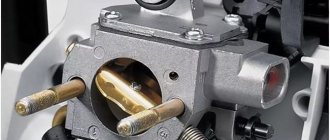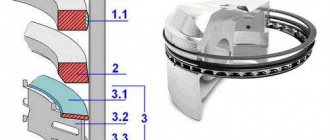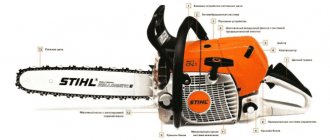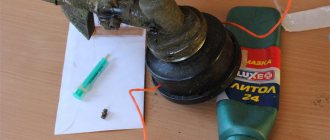As standard, the stihl ms 180 chainsaw comes complete with an instruction manual.
Due to the fact that it was developed by professionals from the German company Stihl, the manual for the chainsaw is written very competently and covers all the main points of operation. Let's look at some points of the instructions from which the owner of the saw can obtain the most necessary knowledge.
Safety instructions
This section contains basic recommendations for the correct and safe operation of the Shtil 180 chainsaw.
From this section you can find out what personal protective equipment should be used when working with a saw, how to transport and clean it. Safety when refueling the Shtil 180 chainsaw is highlighted as a separate item.
Another important subsection of safety is precautions and correct behavior when working. The most important points are marked with special signs that attract attention and emphasize the extreme importance of the information.
How to start a Shtil 180 chainsaw?
You need to start the Stihl chainsaw in the following order:
- First of all, you need to turn on the inertia brake by pulling its plastic lever away from you;
- Next, you need to carefully remove the protective plastic cover;
- Then you will need to press the standard fuel pump button. Thanks to this, fuel will enter the cylinder and it will be easier for the starter to start the engine;
- Next, the combination switch must be set to the permissible position designated “Cold start”;
- Then, grab the Stihl saw with both hands and slowly pull the plastic lever of the built-in factory starter until resistance is felt. Immediately after this, you need to quickly pull the starter lever toward you several times until the standard engine starts and stalls;
- At the end, you need to pull the inertia brake lever towards you and start working with the tool.
By adhering to this procedure, the owner of the Stihl MS 180 model will be able to protect its main working parts from increased wear and significantly extend their service life.
Reactionary forces
The instruction point following the safety section attracts attention at first glance with its picture. The information that can be obtained by reading the “Reaction Forces” section is probably unfamiliar to all those who do not read the instructions for Stihl chainsaws, but prefer to immediately start using them.
In turn, those who read it will receive several unique recommendations and tips for reducing chainsaw kickback and the risk of kickback and will find out why the saw chain brake has exactly this shape and location.
Do-it-yourself adjustment of the Shtil 180 chainsaw carburetor
The factory carburetor of the Stihl brand chain saw plays one of the leading roles in the design of the model. During its operation, he is responsible for mixing the fuel mixture with air and feeding it into the engine cylinder.
Before adjusting the carburetor, you will need to remove the plastic body of the tool and clean the internal parts of the saw from dust and carbon deposits. There are 3 adjustment screws under the housing cover. The first 2 screws are marked with the letters H and L - they are needed to adjust the proportion of fuel and air, which is determined by the level of opening of the throttle valve. When the screws are loosened, the fuel mixture becomes enriched with air, causing the engine speed to drop. If the screws are tightened, the amount of air used in the fuel decreases, which leads to an increase in engine speed.
The screw marked H is required to adjust the maximum engine speed. Screw L is responsible for adjusting the required minimum operating speed of the motor. The third screw, marked S, is needed to fine-tune the operating idle speed of the internal combustion engine of the Stihl MS 180 chainsaw.
Setting up the carburetor of a German brand saw consists of two stages. The first stage is the basic one, or, as it is also called, the factory stage. It can only be done when the engine of the garden tool is turned off. The second stage is the final one. To perform this, a warm engine must be turned on. To know how far to turn the adjustment bolts, you need to read the saw's instructions in advance. It shows the exact setting diagram for each individual screw. Arbitrarily adjusting the bolts without knowing their exact final position can damage the chainsaw motor.
During basic carburetor adjustment with the cold engine turned off, screws H and L must be slowly turned alternately in the direction of the clock hand until it stops. Then each of them needs to be turned 2 full turns in the opposite direction.
The final carburetor adjustment is performed in the following order:
- First you need to start the chainsaw engine and let it run for 5 minutes until it warms up completely;
- Next, you will need to start turning screw H alternately in different directions until the maximum engine speed at idle is found;
- Then the screw marked L must be turned 1/4 turn counterclockwise;
- If after these steps the chain on the bus begins to rotate, then screw S will need to be turned counterclockwise. You only need to finish manipulating the screws S when the saw chain comes to a complete stop;
- Next, you need to set the maximum engine speed using a manual tachometer connected to the engine.
After adjusting the carburetor, you will need to check the operation of the engine. To do this, with the instrument turned on, you must sharply press the gas trigger several times. If, when you quickly press the trigger, the engine sharply gains speed, and when it is released, it loses it, it means that the adjustment of the factory carburetor was performed correctly.
Work technique
This section will be useful to study for those who are picking up the MS 180 for the first time. The technique of cross-cutting, cutting downed wood and the felling process itself are touched upon and discussed in as much detail as possible.
I would like to note that some points in the section concerning, for example, cutting down trees in a certain direction, cannot be found in the operating instructions of other chainsaw manufacturers; it is for this reason that the instructions for the 180th are unique in their content.
After reading the section, you can learn how to properly cut a tree trunk, how to trim branches and the main points regarding safe work. Moreover, all these recommendations and methods are illustrated with the help of numerous drawings and drawings that reflect the essence in as much detail as possible. Thus, the section will be understandable even to people who have never had experience using a saw.
The Shtil 180 chainsaw is a household tool, and when developing the instructions, the manufacturer took care of inexperienced users and tried to make it as detailed as possible.
Ignition faults
Most often, we think about repairs after the chainsaw stops starting, or visual signs of serious damage appear.
Signs of ignition malfunction:
- The chainsaw starts, but works unevenly (troits), often sneezes and shoots;
- The power of the chainsaw has noticeably dropped;
- When you sharply press the accelerator trigger, failures in engine operation are observed;
- The chainsaw does not start well when cold, it stalls violently until it warms up;
- Fuel consumption has increased significantly;
If such flaws appear in the operation of your chainsaw, then it’s time to diagnose, adjust, and possibly repair the ignition system.
Fault location determination:
First of all, it is necessary to inspect the spark plug; if a lot of carbon deposits have accumulated on it, then the cause of the malfunction is most likely related to the operation of the carburetor, piston group or fuel quality. If the spark plug visually appears to be in good working order, does not spark and is dry, make sure there is a spark.
- Unscrew the spark plug, put the ignition cable on it;
- Using insulated pliers, press the spark plug threads to the motor housing;
- Pull the starter handle sharply towards you and make sure there is a spark;
If there is no spark, replace the spark plug with a new one and test again. After making sure there is a spark, start the engine. But what to do if there is no spark even on a working spark plug? Let's continue the search:
- We test the electrical cable for breaks and insufficient contact with the spark plug. We check the serviceability of the spring in the cap of the candle holder and the presence of contact with the armored cable;
To check the serviceability of electrical wiring, it is best to use a tester.
Read also: What to make a mold for casting aluminum from
- We check the gap between the ignition module and the flywheel magnetic circuit. It should be no more than 0.3 - 0.4 mm.
You can set the correct gap using a feeler gauge; they are not in short supply and are available for a small fee.
Diagnosing a fault with a multimeter
The malfunction of the ignition coil can also be determined using the so-called hardware method. However, for this you must have a multimeter with which diagnostics are carried out.
Step-by-step ignition diagnostics with a multimeter:
- We set the multimeter to a position where the arrow is at the 200 ohm mark.
- We study the instructions for the chainsaw. We find out the optimal resistance for the winding of the coil installed on our model (in most modern chainsaws this indicator ranges from 3-5 Ohms);
- We connect a multimeter to the primary winding of the coil and measure the resistance, if it is normal, we continue testing;
- We connect the multimeter to the secondary winding of the coil, compare the readings obtained with those indicated in the instruction manual;
- We connect the multimeter to the hole in the coil into which the wires are inserted. If the device produces normal readings, we come to the conclusion that the coil is working properly. If the measurement results are far from optimal, you will have to replace the assembly (coil) with a new one;
Video review of fault determination using a multimeter
Ignition adjustment
As we have already noted, you can adjust the ignition system both in the workshop and at home. To do this, you will need ordinary wrenches, a screwdriver and a 0.4 mm feeler gauge (you can make a feeler gauge yourself from scrap materials - regular copier paper, a plastic bottle, etc.).
Step-by-step adjustment of the chainsaw ignition:
- We diagnose the malfunction;
- Remove the protective cover;
- We remove the module with a candle holder and an electrical cable. We carry out a visual inspection of them and, if necessary, replace them with a new one;
- We install the ignition module, but do not tighten the fastening screws all the way;
We determine the area with the magnet on the flywheel;
- We set the gap properly, in accordance with the parameters specified in the instruction manual;
- We tighten the module fastening screws until they stop, check the settings with a feeler gauge, and, if necessary, re-adjust;
- We install the protective cover and check for the presence of a spark on the spark plug;
- We screw in the spark plug and start the chainsaw;
Important: when repairing the ignition of a chainsaw, special attention should be paid to setting the correct gap between the module and the flywheel.
You should also check whether the counterweight flywheel is catching on the module. If this happens, you may have a failed bearing or play in the shaft.
Cutting set and saw bar installation
In these sections, the 180's instructions are devoted to the saw set and its correct installation on the saw. Chain links, its tension, protection and much more, which will be useful to everyone who deals with the tool.
The most important information from this section is how tension control is carried out, and what precautions must be taken to avoid injury from sharp saw teeth.
Chainsaw Shtil MS 180 – technical specifications
The high efficiency of the Stihl model in the garden was achieved thanks to decent factory parameters.
Chainsaw features include:
- petrol engine power – 2 liters. s./1.5 kW;
- factory cylinder volume – 31.8 cm3;
- the permissible length of the tire used is 30–35 cm;
- fuel consumption – 200 ml/h;
- the pitch of the chain used is 3/8 “;
- weight including saw set – 4 kg.
The advantages of a chainsaw from the German brand Stihl include a low noise level, which, when the factory engine is running under maximum load, does not exceed 105 dB.
Fuel and refueling
How and with what to fill the tool, lubricate the chain and the consequences of using low-quality fuel, this is what you can learn about from these sections. In fact, many people think that there is nothing to know there, but this is fundamentally wrong, because in this section the 180’s instructions contain a lot of useful information.
For example, such important points as:
- fuel mixture proportion;
- replacing the fuel filter;
- storage of the finished fuel mixture;
- preparing the Shtil chainsaw for refueling.
It will be useful even for those who have extensive operating experience to read and refresh their knowledge.
Starting and stopping the engine
One of the most important points that the 180's instructions contain is starting and stopping the saw engine.
According to unofficial data, the majority of calls to the service center for Shtil chainsaws sold within a month are due to the owners violating the start algorithm for the Shtil 180 chainsaw.
The manufacturer has taken all possible measures to reduce statistics. Wrote detailed instructions and organized mandatory consultations during the sale. But users do not want to read paragraphs dedicated to starting a chainsaw and listen to salespeople, which as a result leads to an increase in the number of calls to the service center.
The starting section also indicates the main positions in which it is most convenient to start the saw, and at the same time protect yourself as much as possible from receiving various types of injuries.
You can watch a video on starting a chainsaw, which shows in detail what position the control lever should be in for different modes of starting the saw.
Chainsaw device Shtil 180
The Stihl MS 180 household chainsaw is equipped with a high-quality branded internal combustion engine, configured from the manufacturer to work in difficult weather conditions. The model’s single-cylinder engine successfully withstands long-term high loads without increasing the amount of fuel consumed, and the forged piston group is resistant to corrosion and the formation of burrs. Engine cooling – improved, through intake air masses. For more convenient operation, the Stihl 180 chainsaw is equipped with a factory vibration suppression system, and to reduce noise during operation, it is equipped with a proprietary muffler.
The tool's clutch device includes a proprietary drive sprocket. It withstands long-term loads and does not slip when the speed increases sharply. This makes the Stihl chain saw more efficient when cutting dry, thick logs.
To make it easier to start a cold factory engine, the Stihl MS 180 chainsaw is equipped with a decompression valve designed for manual pumping of fuel.
The working parts of garden tools are a reinforced metal bar on which a chain is tensioned. For more precise adjustment of the tension of the saw set, the Stihl model is equipped with a proprietary front device. Protecting the operator from a broken chain are front and rear hand guards, as well as a chain catcher. To lubricate the saw set, the model is equipped with a proprietary Ematic lubrication system with a durable oil pump. Additionally, the manufacturer included a toothed stop in the garden tool package for more precise sawing of logs.
The Stihl MS 180 chainsaw is distinguished by its ease of use, which was achieved thanks to the manufacturer’s well-thought-out arrangement of controls. The engine start button, throttle lever, factory plastic starter handle and stock throttle position switch are located at the rear of the model. There is a built-in inertial brake lever at the front.
The final points contained in the instructions of the 180th
In the final part of the article, German engineers have concentrated the most complete information about chainsaw maintenance.
So in the end, the instructions contain the following sections:
- tire maintenance;
- cleaning the air filter;
- carburetor adjustment;
- spark plug;
- storage;
- control and replacement of the drive sprocket;
- all information regarding the technical information of the saw.
A large section is devoted to chain sharpening. You can even say that you won’t be able to find more complete information about sharpening, choosing files and auxiliary tools anywhere except in the Shtil instructions.
The Calm instruction manual is a unique document in terms of the information collected in it, which will be most useful to read both for people without experience and for chainsaw owners with decent experience.
Product manufacturer STIHL
The history of the STIHL brand dates back to 1926, when Andreas Stihl founded. Initially, the company specialized in creating working boilers and the first “washing machines”, and later, with the money earned, the first model of a chainsaw was created. This unit, despite its enormous weight (48 kg), quickly conquered the market and began to be sold very successfully to countries near and far abroad.
The 90s marked the beginning of a family business for the company. Almost all members of the Stihl family began to take part in the life of the company.
In 1995, the AG&Co Holding was created, the main base of which was in Waiblingen and Diesburg.
Manufacturing company STIHL
Since 2002, a complete stranger has become the head of the board of directors of STIHL AG. At that time, boss Hans Peter Stihl headed the company's supervisory board and took over the chairmanship of the commission of STIHL Holding AG&Co.
After another 2 years, the company’s modern development center opened, and already in 2006, a new assembly plant started in China.
Today, the company is successfully developing, introducing new ideas and even more practical approaches into its work. STIHL's inventions top the chainsaw ratings in terms of reliability.
